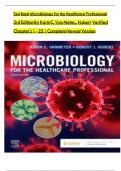Test Bank Microbiology for the Healthcare Professional
k k k k k k
3rd Edition By Karin C. Van Meter,. Hubert Verified
k k k k k k k kk
Chapter's 1 - 25 | Complete Newest Version
k k k k k k k k
,Table of content k k
1. Scope of microbiology
kk k k
2. Chemistry of life
kk k k
3. Cell structure and function
kk k k k
4. Bacteria and archaea
kk k k
5. Viruses
kk
6. Eukaryotic microorganisms
kk k
7. Physical and chemical methods of control
kk k k k k k
8. Microbiological laboratory techniques
kk k k
9. Microbiological laboratory safety issues
kk k k k
10. Pharmacology
kk
11. Antimicrobial drugs
kk k
12. Infection and disease
kk k k
13. The immune response and lymphatic system
kk k k k k k
14. Infections of the integumentary system, soft tissue, and musculoskeletal system
kk k k k k k k k k k
15. Infections of the respiratory system
kk k k k k
16. Infections of the gastrointestinal system
kk k k k k
17. Infections of the nervous system and sensory structures
k kk k k k k k k k
18. Infections of the cardiovascular and circulatory systems
k kk k k k k k k
19. Infections of the urinary system
k kk k k k k
20. Infections of the reproductive system
kk k k k k
21. Sexually transmitted infections and diseases
k kk k k k k
22. Human age and microorganisms
kk k k k
23. Microorganisms in the environment and effects on human health
k kk k k k k k k k k
24. Emerging infectious diseases
kk k k
25. Biotechnology
kk
,Chapter 01: Scope of Microbiology
k k k k
VanMeter: Microbiology for the Healthcare Professional, 3rd Edition
k k k k k k k
MULTIPLE CHOICE k
1. In the sixteenth century a father-and-son team, by the name of
k k k k k k k k k k , produced
k
acompound microscope consisting of a simple tube with lenses at each end.
k k k k k k k k k k k k k
a. van Leeuwenhoek k
b. Semmelweis
c. Janssen
d. Hooke
ANS: C k REF: p. 3 k k
2. “Animalcules” were first described by k k k k
a. Robert Hooke. k
b. Antony van Leeuwenhoek. k k
c. Hans Janssen. k
d. John Needham. k
ANS: B k REF: p. 3 k k
3. Micrographia, a publication illustrating insects, sponges, as well as plant cells, was publishedby
k k k k k k k k k k k k k
a. Robert Hooke. k
b. Antony van Leeuwenhoek. k k
c. Hans Janssen. k
d. John Needham. k
ANS: A k REF: p. 3 k k
4. Low-power microscopes designed for observing fairly large objects such as insects or wormsare
k k k k k k k k k k k k k
a. electron microscopes. k
b. dark-field microscopes. k
c. fluorescence microscopes. k
d. stereomicroscopes.
ANS: D k REF: p. 5 k k
5. A microscope that provides a three-dimensional image of a specimen is a
k k k k k k k k k k k
a. dark-field microscope. k
b. transmission electron microscope. k k
c. bright-field microscope. k
d. scanning electron microscope. k k
ANS: D k REF: p. 7 k k
6. The tool of choice to observe living microorganisms is the
k k k k k k k k k
a. bright-field microscope. k
b. phase-contrast microscope. k
, c. fluorescence microscope. k
d. electron microscope. k
ANS: B k REF: p. 6 k k
7. Which scientist is most responsible for ending the controversy about spontaneous generation?
k k k k k k k k k k k
a. John Needham k
b. Joseph Lister k
c. Louis Pasteur k
d. Robert Koch k
ANS: C k REF: p. 8 k k
8. Fossils of prokaryotes go back
k k k k billion years. k
a. 4.0 to 5.0 k k
b. 3.5 to 4.0
kk k k k
c. 2.5 to 3.0 k k
d. 2.2 to 2.7
kk k k k
ANS: B k REF: p. 9 k k
9. Molds belong to which of the following groups of eukaryotic organisms?
k k k k k k k k k k
a. Protozoans
b. Archaea
c. Fungi
d. Algae
ANS: C k REF: p. 11 k k
10. The correct descending order of taxonomic categories is
k k k k k k k
a. species, domain, phylum, kingdom, order, division, class, genus.
k k k k k k k
b. domain, kingdom, phylum, class, family, order, genus, species.
k k k k k k k
c. domain, kingdom, phylum, class, order, family, genus, species.
k k k k k k k
d. kingdom, domain, phylum, order, class, family, genus, species.
k k k k k k k
ANS: C k REF: p. 10 k k
11. Complex communities of microorganisms on surfaces are called
k k k k k k k
a. colonies.
b. biofilms.
c. biospheres.
d. flora.
ANS: B k REF: p. 12 k k
12. A relationship between organisms in which the waste product of one provides nutrients for
k k k k k k k k k k k k k
another is called
k k k
a. mutualism.
b. competition.
c. synergism.
d. commensalism.
ANS: D k REF: p. 12 k k




